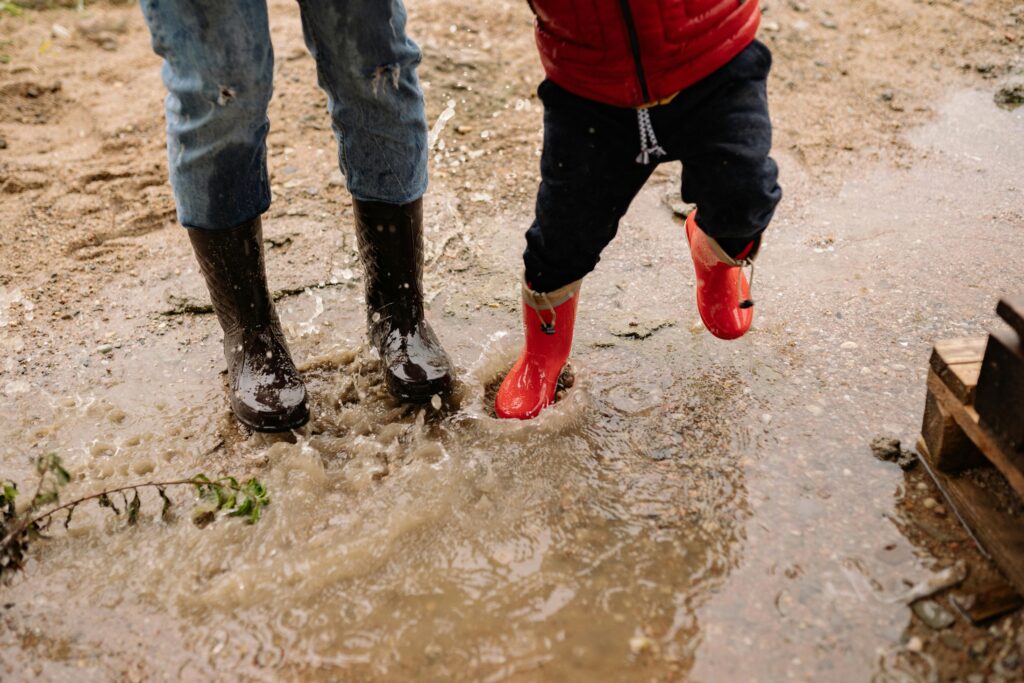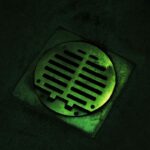If you’ve ever stepped into your yard after a heavy rainfall and felt your shoes sink into sticky mud, you already know the frustration of clay soil drainage issues. Clay soil is common across many regions, but its dense structure can trap excess water, suffocate plant roots, and create major drainage problems around your home and basement.
Fortunately, with the right drainage systems, soil amendments, and landscaping strategies, even the heaviest clayey soil can be transformed into a healthy, thriving environment. This guide walks you through everything homeowners should know about clay soil drainage systems—from understanding your soil types to choosing the best way to manage wet clay soils long-term.
Understanding Clay Soil and Why It Causes Drainage Problems
Clay soil forms from fine clay particles—the smallest soil particles of all. These fine particles pack tightly together, leaving little pore space for air pockets or water movement. As a result, clay holds onto much water and drains slowly.
Unlike sandy soil or loamy soil, heavy clay soil has poor soil structure, meaning it compacts easily and stays wet for long periods. When heavy rains or winter rains hit, surface water struggles to drain away, often creating low spots and wet soil around your home.
The Nature of Clay Soil
Clay is rich in essential nutrients and supports beneficial microorganisms, but without good drainage systems, it can quickly turn into a sticky mess. The nature of clay soil means it’s slow to warm in spring, prone to soil compaction, and sensitive to foot traffic—all of which can restrict root growth and plant health.
Signs of Poor Drainage in Clay Soil
Knowing when your yard has poor drainage helps you fix problems before they damage your foundation or landscaping. Common warning signs include:
- Standing surface water that lingers for more than 24 hours
- Puddles forming in the same parts of the yard after every heavy rainfall
- Yellowing or wilting plants due to overwatered clay soil
- Moss growth, soil erosion, or compacted patches where grass won’t grow
- Musty smells and soft, spongy soil around your garden soil or foundation walls
If these symptoms sound familiar, your clay soil drainage likely needs improvement—and there are multiple effective ways to do it.
How Clay Soil Affects Plant Growth and Soil Health
Healthy soil needs a balance of air, water, and organic matter. In clay, those elements get out of balance quickly. Excess water fills the gaps between fine particles, pushing out oxygen and creating anaerobic conditions. This deprives plant roots of the air they need and encourages rot.
Over time, this reduces soil health, kills beneficial microorganisms, and limits the uptake of essential nutrients. That’s why even if you add fertilizer, your plants may still struggle.
The goal of any clay soil drainage system is to restore balance—to improve pore space, boost water flow, and support healthy soil that promotes deep roots and strong plant growth.
Step 1: Assess the Type of Soil in Your Yard
Before you can fix drainage issues, you need to understand your soil types. A simple soil test from your local county extension service or garden center can reveal:
- Percentage of clay, silt, and sand
- Soil pH (acidic or alkaline)
- Nutrient levels and organic matter content
If your soil feels sticky and forms a tight ribbon when rolled in your hand, it’s likely heavy clay soil. Loam soil—a balanced mix of sandy soil, silt, and clay—offers better drainage, while sandy soil drains quickly but may lack nutrients.
This test helps you determine what kind of soil amendments or drainage systems will deliver the best results.
Step 2: Improve Soil Structure with Organic Matter
Adding organic material is the single best way to improve clay soil drainage. Organic matter—like compost, aged manure, or shredded leaves—loosens the heavy soil, improves soil structure, and encourages beneficial microorganisms that create natural pore space.
Organic Amendments to Try
- Compost: Builds healthy soil and adds essential nutrients.
- Peat moss: Retains moisture while improving drainage.
- Aged manure: Adds organic food sources for microbes.
- Gypsum (Calcium Sulfate): Helps break up compacted soil without changing soil pH.
Apply 2–4 inches of organic amendments to the soil surface, then till or mix it 6–8 inches deep. Over time, this creates a rich clay soil garden that supports strong root growth and better drainage.
Mix in organic compost and a calcium-sulfate soil conditioner like this garden gypsum to help break up compacted clay and improve drainage naturally.”
Step 3: Install Drainage Systems for Clay Soil
When soil amendments alone aren’t enough, a drainage system can direct excess water away from problem areas. Here are several homeowner-friendly systems for clay soil yards.
1. French Drain System
A French drain system is one of the most effective ways to fix drainage issues in wet clay soils. It uses a deep trench filled with gravel and a perforated pipe to redirect water flow away from low areas.
How to Build a French Drain:
- Locate low spots or areas with standing water.
- Dig a deep trench (at least 18–24 inches).
- Line the trench with filter fabric to prevent fine particles from clogging it.
- Place a perforated drain pipe and cover it with clean gravel.
- Finish with a few inches of topsoil and turf.
This allows water movement underground, keeping your soil surface dry and preventing soil erosion.
If you’re building a DIY French drain system, start with a perforated pipe kit like this one on Amazon and wrap it with filter fabric to prevent clogging from fine clay particles.”
2. Channel Drain or Area Drain
For patios, driveways, or small areas that collect surface water, a channel drain or area drain works well. These connect to storm drains or catch basins, capturing runoff and sending it to a safe outlet.
A catch basin placed at the lowest point of your yard is a good idea for collecting surface runoff before it pools near your home or garden.
For driveways or patios that flood easily, a simple channel drain kit like this one on Amazon connects directly to your downspouts for efficient surface water control.
3. Dry Creek Bed or Dry Riverbeds
A dry creek bed or dry riverbed not only manages water flow but also adds natural beauty to your landscape. It mimics a small stream lined with rocks, directing wet weather runoff away from your house.
When properly graded with a slight slope, these systems offer both better drainage and erosion control—especially in large areas with heavy rainfall.
4. Rain Garden
A rain garden uses native plants and deep-rooted cover crops to absorb surface water naturally. These plants thrive in wet clay soils, reduce water retention, and filter pollutants before water enters groundwater or storm drains.
Over time, rain gardens improve soil health, provide a vital role in water management, and attract pollinators—perfect for homeowners seeking eco-friendly drainage solutions. This is something that is recommended by EPA.
Step 4: Reduce Soil Compaction
Compacted soil worsens clay soil drainage by squeezing out air pockets and reducing pore space. Avoid working wet soil or walking on it after heavy rains—this pushes particles closer together, making it even harder for water to drain.
Tips for Preventing Compaction:
- Use stepping stones or pathways to minimize foot traffic.
- Aerate garden soil annually with a core aerator.
- Add organic matter to keep soil loose and healthy.
- Use deep-rooted cover crops (like rye or clover) during the growing season to break up heavy soil naturally.
Step 5: Direct Water Away from Foundations
One of the most important parts of any clay soil drainage system is protecting the space beneath your home — especially the foundation and crawl space. In regions with heavy clay soil, the ground tends to hold on to excess water after every storm. When that trapped moisture collects around your foundation walls, it often seeps into crawl spaces, creating musty odors, wood decay, and long-term structural problems. Why Crawl Spaces Are Vulnerable in Clay Soil Areas
Clay soil expands dramatically when wet and shrinks as it dries. That constant swelling and contraction puts stress on footings and support piers, causing small cracks that allow water to enter. Because crawl spaces sit just below the soil surface, even minor drainage issues in wet clay soils can result in a humid, muddy, or flooded area under the home.
When combined with a high water table, heavy rains, or poor grading, this moisture can contribute to:
- Foundation settlement and shifting joists
- Mold and mildew growth on floor beams
- High humidity levels that affect indoor air quality
- Pest infestations attracted to damp wood
Proper water management keeps your crawl space dry and your foundation structure stable. If you’re already seeing cracks or uneven floors, it may be time for a free foundation inspection.
Practical Steps for Protecting Crawl Spaces
- Grade the Soil Correctly
- Ensure that the soil surface slopes away from the foundation by at least one inch per foot for the first six feet. A slight slope prevents surface water from pooling near crawl-space vents and keeps the surrounding garden soil from staying waterlogged.
- Extend Downspouts and Use Splash Blocks
- Redirect roof runoff at least 6–10 feet away from your foundation. Downspouts that empty near the house are one of the top causes of overwatered clay soil around crawl spaces.
- Install a Perimeter Drain or French Drain System
- In areas with poor drainage, a French drain system or area drain installed around the foundation footing can collect excess water before it seeps below the structure. Use a perforated pipe wrapped in filter fabric and surrounded by gravel to promote water flow without clogging from fine clay particles.
- Add a Sump Pump Inside the Crawl Space
- A sump pump provides active protection during heavy rainfall or wet weather. Water that collects under the vapor barrier or at the low spots of your crawl space is automatically pumped outside to a safe discharge point or storm drain.
- Encapsulate the Crawl Space
- After you’ve controlled outside water, consider crawl-space encapsulation. This process seals the ground and walls with a thick vapor barrier, preventing moisture intrusion from wet clay soils. Encapsulation also improves soil health beneath the barrier by limiting the conditions that cause mold and wood rot.
- Ventilation and Dehumidification
- Use a mechanical dehumidifier or vent fan to maintain humidity below 60 percent. Controlling moisture levels discourages beneficial microorganisms from turning anaerobic and stops condensation on ducts and insulation. If you have persistent basement moisture try improving air quality with the best dehumidifier for allergies.
Step 6: Manage Water Wisely During Wet and Dry Periods
Overwatered clay soil can be just as damaging as dry spells. Practice balanced water management to protect soil health all year.
During Wet Weather:
- Check downspouts and drains regularly for clogs.
- Avoid planting during winter rains when wet soil compacts easily.
During Dry Spells:
- Add mulch to maintain moisture balance.
- Water deeply but infrequently to promote deep roots.
- Maintain a layer of organic matter to retain essential nutrients.
Climate change is bringing more unpredictable heavy rains followed by dry spells, so a combination of drainage systems and healthy soil practices gives your yard long-term resilience.
Step 7: Maintaining Long-Term Soil Health
Fixing clay soil drainage isn’t a one-time project—it’s an ongoing commitment to soil health and water management. Each season, check for settling, clogged drains, or erosion around your dry creek bed or rain garden.
Continue enriching the soil with organic matter, aerating compacted spots, and planting native plants that adapt to climate change and wet weather. Over time, your yard will develop good drainage, support plant growth, and stay healthier year-round.
When to Call a Drainage Contractor
If standing water persists despite your efforts—or if your basement or crawl space shows signs of moisture—it’s time to call a licensed drainage contractor. They can:
- Perform a full yard evaluation
- Install a French drain system or area drain
- Address high water table concerns
- Ensure compliance with local drainage codes
Hiring an expert can be a good idea for complex large areas or low spots that repeatedly flood. For smaller spaces, many of these DIY drainage methods work beautifully when installed with care.
Final Thoughts: Turning Wet Clay into Healthy, Productive Soil
Fixing clay soil drainage takes patience, but the payoff is worth it. With improved soil structure, the right drainage systems, and a steady supply of organic material, you can transform your soggy yard into a thriving landscape.
Remember—the type of soil you have doesn’t have to limit your garden’s potential. With smart water management, proper grading, and healthy soil amendments, even heavy clay soil can become a place where native plants, flowers, and trees grow deep, strong roots.
For homeowners, the best way to start is simple: test your soil, amend it generously, and choose a clay soil drainage system that fits your property’s needs. Over time, your soil will drain freely, plants will flourish, and your foundation will stay dry—giving you peace of mind through every rainy season.



